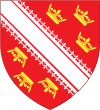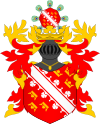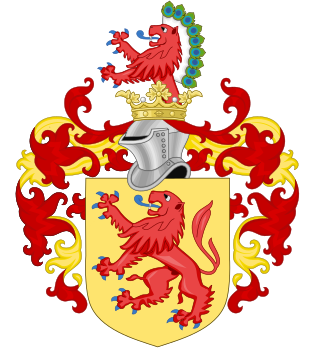
The House of Habsburg, also known as the House of Austria, is one of the most prominent and important dynasties in European history.
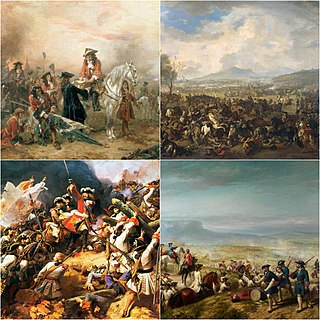
The War of the Spanish Succession was a European great power conflict fought between 1701 and 1714. The immediate cause was the death of the childless Charles II of Spain in November 1700, which led to a struggle for control of the Spanish Empire. His nominated heir was Philip of Anjou, a grandson of Louis XIV of France, whose main backers were France and most of Spain. His rival, Archduke Charles of Austria, was supported by the Grand Alliance, whose primary members included the Holy Roman Empire, the Dutch Republic, and Great Britain. Significant related conflicts include the 1700 to 1721 Great Northern War, and Queen Anne's War in North America.

Sigismund, a member of the House of Habsburg, was Duke of Austria from 1439 until his death. As a scion of the Habsburg Leopoldian line, he ruled over Further Austria and the County of Tyrol from 1446 until his resignation in 1490.

Matthias was Holy Roman Emperor from 1612 to 1619, Archduke of Austria from 1608 to 1619, King of Hungary and Croatia from 1608 to 1618 and King of Bohemia from 1611 to 1617. His personal motto was Concordia lumine maior.

This article is about the history of Hesse. Hesse is a state in Germany.

The House of Lorraine originated as a cadet branch of the House of Metz. It inherited the Duchy of Lorraine in 1473 after the death without a male heir of Nicholas I, Duke of Lorraine. By the marriage of Francis of Lorraine to Maria Theresa of Austria in 1736, and with the success in the ensuing War of the Austrian Succession (1740–1748), the House of Lorraine was joined to the House of Habsburg and became known as the House of Habsburg-Lorraine. Francis, his sons Joseph II and Leopold II, and his grandson Francis II were the last four Holy Roman emperors from 1745 until the dissolution of the empire in 1806. The House of Habsburg-Lorraine inherited the Habsburg Empire, ruling the Austrian Empire and then Austria-Hungary until the dissolution of the monarchy in 1918.

Lenzburg Castle is a castle located above the old part of the town of Lenzburg in the Canton of Aargau, Switzerland. It ranks among the oldest and most important of Switzerland. The castle stands on the almost circular castle hill, which rises approximately 100 m (330 ft) over the surrounding plain but is only about 250 m (820 ft) in diameter. The oldest parts of the castle date to the 11th century, when the Counts of Lenzburg built it as their seat. The castle, its historical museum and the castle hill with its Neolithic burial grounds are listed as heritage sites of national significance.

Further Austria, Outer Austria or Anterior Austria was the collective name for the early possessions of the House of Habsburg in the former Swabian stem duchy of south-western Germany, including territories in the Alsace region west of the Rhine and in Vorarlberg.
Sundgau is a geographical territory in the southern Alsace region, on the eastern edge of France. The name is derived from Alemannic German Sunt-gowe, denoting an Alemannic county in the Old High German period. The principal city and historical capital is Altkirch.

During the Middle Ages, an advocatus was an office-holder who was legally delegated to perform some of the secular responsibilities of a major feudal lord, or for an institution such as an abbey. Many such positions developed, especially in the Holy Roman Empire. Typically, these evolved to include responsibility for aspects of the daily management of agricultural lands, villages and cities. In some regions, advocates were governors of large provinces, sometimes distinguished by terms such as Landvogt.
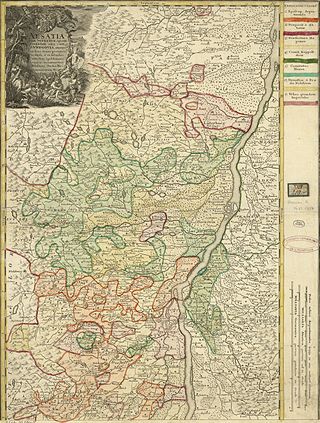
Lower Alsace was a landgraviate of the Holy Roman Empire held ex officio by the Bishop of Strasbourg. Prior to is acquisition by the bishopric, it was held by the counts of Hüneburg.

The Archduchy of Austria was a major principality of the Holy Roman Empire and the nucleus of the Habsburg monarchy. With its capital at Vienna, the archduchy was centered at the Empire's southeastern periphery.

The Old Swiss Confederacy, also known as Switzerland or the Swiss Confederacy, was a loose confederation of independent small states, initially within the Holy Roman Empire. It is the precursor of the modern state of Switzerland.
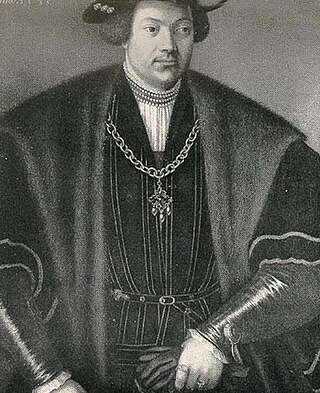
Gabriel von Salamanca was a Spanish nobleman who served as general treasurer and archchancellor of the Habsburg archduke Ferdinand I of Austria from 1521 to 1526. He was elevated to a Count of Ortenburg in 1524.

The Château de Ferrette is a ruined castle in the commune of Ferrette in the Haut-Rhin département of France. It is a recognized historical monument since 1930.

The Château d'Ochsenstein is a ruined castle located in the commune of Reinhardsmunster, in the Bas-Rhin département of France. It was home to the Ochsensteins, a powerful family from medieval Alsace. The castle sits upon three sandstone spurs and comprises three separate castles: le Grand Ochsenstein, le Petit Ochsenstein and a third building, thought to be called le Château de Wachelheim.
The Duchy of Thuringia was an eastern frontier march of the Merovingian kingdom of Austrasia, established about 631 by King Dagobert I after his troops had been defeated by the forces of the Slavic confederation of Samo at the Battle of Wogastisburg. It was recreated in the Carolingian Empire and its dukes were appointed by the king until it was absorbed by the Saxon dukes in 908. From about 1111/12 the territory was ruled by the Landgraves of Thuringia as Princes of the Holy Roman Empire. When Frederick IV, the last independent ruler of Thuringia died in 1440, the territory passed to his nephew, the Saxon elector Frederick II.
In the Treaty of Saint-Omer, Archduke Sigismund of Habsburg mortgaged the County of Ferrette along with the Landgraviate of Upper Alsace to Duke Charles the Bold, in Saint-Omer (Pas-de-Calais) on 9 May 1469. The treaty laid the foundation for the Burgundian Wars.

The County of Ferrette was a feudal jurisdiction in Alsace in the Middle Ages and the early modern period. It roughly corresponds with the Sundgau and comprised the lordships of Ferrette (Pfirt), Altkirch, Thann, Belfort, Rougemont and others. These territories were not contiguous, but formed a patchwork of jurisdictions under the Holy Roman Empire.

The Province of Alsace was an administrative region of the Kingdom of France and one of the many provinces formed in the late 1600s. In 1648, the Landgraviate of Upper-Alsace was absorbed into the Kingdom of France and subsequently became the Province of Alsace, which it remain an integral part of for almost 150 years. In 1790, as a result of the decree dividing France into departments, the province was disestablished and split into three departments: Bas-Rhin, Haut-Rhin, and part of Moselle.




















